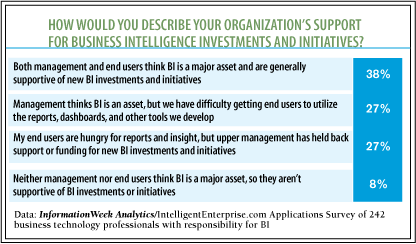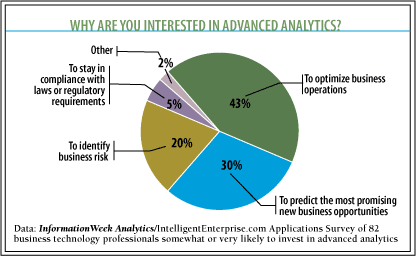Readers Weigh In On Biggest Obstacles To Business SuccessReaders Weigh In On Biggest Obstacles To Business Success
Applications are important, but what IT really needs to improve intelligence, processes and performance is more business direction.

 To develop our 2009 information Analytics/Intelligent Enterprise.com Reader Priorities report, we asked 305 business technology professionals to select their biggest obstacles to business success from among a dozen IT maladies known to plague enterprises. The top three challenges? Adapting business processes for changing conditions; accessing relevant, timely, or reliable data; and integrating, normalizing, or cleansing data. Developing vital reports, metrics, dashboards, or alerts came in close behind.
To develop our 2009 information Analytics/Intelligent Enterprise.com Reader Priorities report, we asked 305 business technology professionals to select their biggest obstacles to business success from among a dozen IT maladies known to plague enterprises. The top three challenges? Adapting business processes for changing conditions; accessing relevant, timely, or reliable data; and integrating, normalizing, or cleansing data. Developing vital reports, metrics, dashboards, or alerts came in close behind.
These results tell us that, despite all the progress and sophistication of enterprise IT, many companies still struggle with the basics of information management. After all, you won't be worrying about reducing data latency and supporting faster decision-making if you're still stuck at the first-level challenge of accessing and integrating data. And customizing or optimizing business processes and applications is unlikely to be a concern for those who can't get past an inflexible corporate culture and slow-moving IT development regimes that aren't keeping pace with fast-changing business conditions.
An information Analytics Webcast
Resetting Information and BI Priorities for a Challenging Economy
Presented by Intelligent Enterprise & sponsored by IBM
But what really surprised us is that, when asked what would improve their productivity, respondents ranked "better guidance from business leaders" first, and "additional financial support or additional staff" dead last among 10 possible responses. That's good news in that the "IT investment" these respondents are asking for is as much about time, organization, and leadership commitments as it is about hard-cash outlays. Now, top executives will likely have their hands pretty full over the next few quarters, so it might be tougher than ever to get their attention. And we're guessing it would not be a good career move to waltz into the executive suite and declare, "You really need to be doing a better job communicating strategy, and while you're at it, how about more support for our IT initiatives?"
Get the full-length
Analytics Report at:
business-optimization.techweb.com
>> See all our Analytics Reports <<
Of course, the usual advice to "gain high-level sponsorship" certainly applies, but we'd hit the ball right back into IT's court and challenge CIOs and tech pros to engage line-of-business leaders. Particularly in these times, it's incumbent on everyone to understand the organization's mission and proactively seek direction from business leaders, rather than waiting for orders from above.
Bridge The Great Divide
On the business intelligence front, lots of organizations are high on BI, with 38% of those responsible for BI initiatives saying that support is unanimous from the corner office to the cubicle. Still, for 27% of respondents, funding is a sticking point. End users are eager to see more reports and gain better insight, but upper management has held back support or funding for new BI investments and initiatives. The opposite problem is seen by the 27% who agree that management sees BI as an asset, but have difficulty getting end users to utilize the reports, dashboards, and other tools they develop.

Whether you're facing a bottom-up or top-down disconnect, no amount of technology investment will bridge this divide. If you can't sell BI to C-level executives, it's likely you're either not telling the story effectively, or you're not delivering results that are making a big difference to the business. If end users aren't buying into BI, it could be a matter of inadequate training or overly complicated technology--but first consider whether the BI team is truly tuned into end user needs.
An increasingly popular institution that can help bridge the management-to-user divide is the BI competency center (BICC), or BI center of excellence. The goal in setting up a BICC is to share proven practices and lessons learned across the organization. Ideally, BICCs are cross-disciplinary teams including both IT and business leaders, and they're most effective when sponsored by the COO, CFO, or other senior leader. CIOs can lead these groups, too, but be careful not to send the message that the BICC is primarily about technology.
C-level support will obviously help when it comes to management buy-in, but the BICC's role also is to set high-level goals and choose achievable projects that will really pay off for the business. Most importantly, BICCs bring together business leaders, architects, developers, and IT types to get buy-in on what's possible and achievable, and they monitor and fine-tune the results. If the reports or dashboards emerging from a project aren't useful or understandable to end users, for example, the BICC team should do whatever it takes to fix the problem.
In some cases, BI technology itself can be the root cause of a usability problem, so BICCs must have the clout to make tough decisions. For example, the greater good may be served by moving away from limited or antiquated tools preferred by one department in favor of a new enterprise-wide standard. "A lack of tool standards limits collaboration and portability of applications, and it also increases training and software licensing costs," says Claudia Imhoff, founder and president of BI consultancy Intelligent Solutions. "If you have the responsibility but not the authority to change anything, your BICC will be rudderless."
Get the full-length
Analytics Report at:
business-optimization.techweb.com
>> See all our Analytics Reports <<
Here again the situation calls for support from on high, so don't waste people's time on a BI competency center if you can't secure senior-level support. It's notable that respondents ranked BICCs toward the bottom of possible productivity boosters, but we think BI practitioners tend to overestimate the burdens of holding meetings and working in concert with others while underestimating the importance of methodical BICC collaboration and review processes.
Spread Wealth, Predict The Future
Drilling down on where BI technology buyers are likely to invest, dashboards, ad hoc reporting, and advanced analytics top the list. The common theme in the first two selections is a desire to spread access to insight. Dashboards are rapidly displacing conventional reports as the front-line means by which day-to-day decision makers gain access to BI. These easy-to-use interfaces pack a variety of key metrics onto a single screen so users can monitor business conditions at a glance.
What's more, dashboards usually can be customized by end users, so they offer a way to share insight without the cost, complication, or IT hand-holding required by more conventional query and reporting tools.
Ad hoc query and reporting tools are becoming an option for self-service access to information. If a production report provides baseline insight into, say, top customers by region, product, and quarter, a modern ad hoc tool lets users drill down to find out which regions or salespeople had gains and which had losses. Just a few years ago, most ad hoc tools were geared to BI power users, but some tools are now easy enough for casual users to master.
Advanced analytics encompasses a variety of mathematical techniques that can be used to calculate attributes that can't be reported straight from the underlying data. Predictive analytics, for example, can crunch current and historical transaction figures to model a customer's likelihood to default on a loan or respond to an up-sell offer.

Among the 82 respondents who are likely to invest in advanced analytics in the next two years, 43% say the main factor driving demand is the desire to optimize business operations, particularly factors such as pricing or profitability. Cross-selling, up-selling, and other customer marketing initiatives are driving 30% of respondents. Business risk applications such as churn analysis, fraud detection, and credit scoring are cited as the top draw by 20% of these respondents.
Get the full-length
Analytics Report at:
business-optimization.techweb.com
About the Author
You May Also Like






